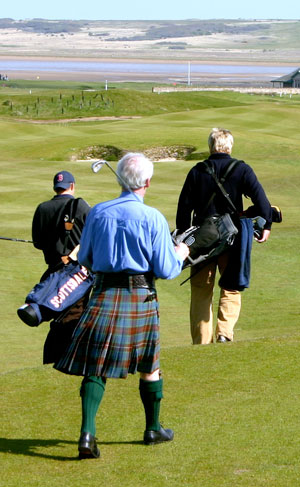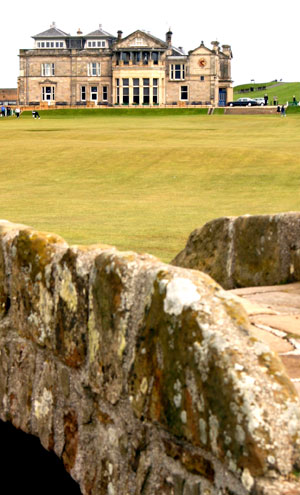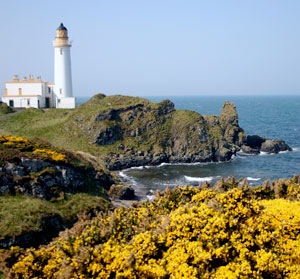ST. ANDREWS, SCOTLAND - The great Bobby Jones once said: "A golfer can not be considered a true champion unless he has won at St. Andrews."
And all the greats have won here - Jones, Ben Hogan, Arnold Palmer, Jack Nicklaus and Tiger Woods, who was crowned Open Champion for the second time at St. Andrews last July.
So, as you can imagine, my legs shook, my hands trembled and my heart almost jumped out of my chest with excitement when it came time for me to stand on St. Andrews' immortalized "first" tee. I prayed to the golf gods to "please, just let me hit the ball" as a group of Japanese tourists looked on.
Whack!
The ball sailed straight down the centre of the pasture-wide course, coming to rest just a few metres in front of the famous burn (stream) that cuts across the shared first and 18th fairways.
Phew!

Above: The Scots take their golf seriously.
"Bravo!" said one of the onlookers from beneath her umbrella. My caddy was also impressed.
"I've seen titans of industry turn to jelly on the first tee," John tells me as we head for my second shot. "Some have cried with excitement."
My first-ever game at St. Andrews is the last on a week-long golf tour of a country generally credited with developing a game that has evolved into a mega industry, encompassing both sport and tourism.
There is no better proof of that than St. Andrews, which has benefited greatly by golf's popularity, especially since Woods came along.
Many of historic St. Andrews' weathered buildings are now home to golf shops or inns and restaurants which cater to the golf crowd. Because Woods has made the game so popular worldwide, new, mega hotels and golf complexes are being built just a few kilometres from the centre of St. Andrews to handle the increasing number of tourists.
But, as I discovered, Scottish golf is so much more than St. Andrews. It's a collection of courses and towns and pubs and people who make visitors feel welcome - especially after each round over a pint in the local.

Above: The Old Course at St. Andrews is golf's Vatican.
From start (at a golf-crazy town called Gullane) to finish (St. Andrews) my Scottish golf holiday was a thrill of a lifetime. Getting a chance to play legendary courses and seeing the remarkable Scottish landscape that lies between each tee is something that I will not soon forget.
Where else but Scotland could you come across a charming wee lass named Ama (Nisbet), whom, at 18 months old, was being taught how to hold a golf club by her proud father (Scott) in a small clearing next to Gullane's No. 2 course in East Lothian.
"We start them young here," said Scott, who tells me: "There are three courses in this area that are restricted to children."
Later, another Scottish golfer tells me that there's legislation here that gives youngsters free access to all golf courses up until 9 years old.
They have been playing golf in Gullane for almost 300 years now - and a delightful man named Archie Baird says he has proof of that "somewhere in this shop."
The rumpled-looking Archie is the self proclaimed curator of a makeshift museum that rests next to the town cemetery. His shop is alive with golf history - everything from feathered balls, to primitive clubs, to old paintings showing people playing the game on ice.
Ice!
"We Scots may have developed the game but a form of golf was actually played in Holland on ice covered rivers in the 13th century, long before it reached our shores," Archie tells me.
"You see the men in that painting playing on a Dutch river. Notice what they are wearing?" Archie asks in a thick brogue.
"That's right, they're in kilts, proving the Scots (they traded regularly with the Dutch back then) brought the game back here and developed it."
The history lesson over, it's time to play Gullane's No. 2 course, which sits a short drive outside Glasgow. It's our first introduction to Scottish golf and it's a great start - Gullane's rolling fairways and challenging greens are a delight to play. Long walks up steep hills (golf carts are for sissies and Americans) and between tees put our stamina to the test.
There are 20 courses every bit as good as this one in the area. There's even legendary Muirfield, located just over a hill from Gullane. It, too, regularly hosts the Open Championship - a.k.a. as the British Open.
The courses here - one of the most delightful is Cragielaw Golf Club where Eric Grandison's learning academy is rated among the finest in the British Isles - make Gullane and its neighbouring towns very popular with golf tourists. Many townsfolk even rent out their homes to golf groups as a way of making extra cash. Some of the homes go for less than $1,000 a week, making this a real bargain for golf foursomes.
After a delightful day at Gullane it's time to head for our second stop, Turnberry. The roads leading to this fabled course, that was a regular in the Open Championship rotation until a few years ago, are lined with history and some of the most breathtakingly beautiful scenery this traveller has ever seen.
Turnberry's majestic white hotel, perched atop a hill overlooking its two fabulous courses and the sea, has been a beacon for golfers for decades. It's a five-star resort that offers upscale accommodation, restaurants and a spa that takes a back seat to no one.
Upon arrival, we head for a warm up round on the resort's lesser known Kintyre course in preparation for our outing the following day on Turnberry's amazing Ailsa Course, which has played host to the Open three times.
Kintyre is a challenging layout lined with hundreds - no thousands - of pretty but lethal gorse bushes that prove to be a major obstacle to my game.
"If your ball goes into the gorse, you'd be wise to play another," advises a Turnberry regular.
It's sound advice since the thick bushes with the pretty yellow flowers and razor sharp thorns have been known to slice a golfer's hand.

Above: Turnberry is one of the world's great courses.
Kintyre is lovely and a good warm up for Ailsa, so called for the legendary island Ailsa Craig that golfers can see - on a clear day - from most every tee.
"You'll play a lot of great golf courses in Scotland but none finer than this," boasts the starter at Ailsa the next morning. The man knows his golf courses because Ailsa, rated among the top three courses in Great Britain, is everything he promised - and more. Sand dunes, pot bunkers, thick rough, sea vistas, rolling greens - the challenging but fair Ailsa is Scottish golf at its best.
The front nine of this picture-perfect course funnels to a point where a lovely lighthouse juts out into the azure sea. Play tends to slow here because groups stop and have their photographs taken in front of the landmark lighthouse.
Turnberry is hard to say goodbye to but St. Andrews awaits. So does a drive that takes us through incredible Edinburgh. Even through a steady rain, the graceful UNESCO World Heritage city built on a volcanic ridge looks stunning. It's bold Georgian-style homes, grand squares, majestic statues, bustling streets and dominate castle make us all vow to return.
"It's hard to concentrate on golf when you have all these other distractions (Edinburgh, Glasgow, quaint towns, history) along the way, isn't it?" John, my St. Andrews caddy, jokingly remarks as we near the end of my Old Course experience.
Just as the Old Course's stunning stone clubhouse comes into view as we approach the 18th tee, the sun peeks through a bank of clouds - a perfect opportunity to stop and have our photographs taken on the legendary Swilcan Bridge, which crosses the burn.
The Old Course, with its deep hidden bunkers and almost impossible pin settings on the greens, is too much course for a mere mortal golfer like me. You need the talent of a Tiger Woods to score well here.
But scores don't really matter at St. Andrews. What matters is that you got a chance to walk these hallowed grounds that are soaked with tradition - and rain.